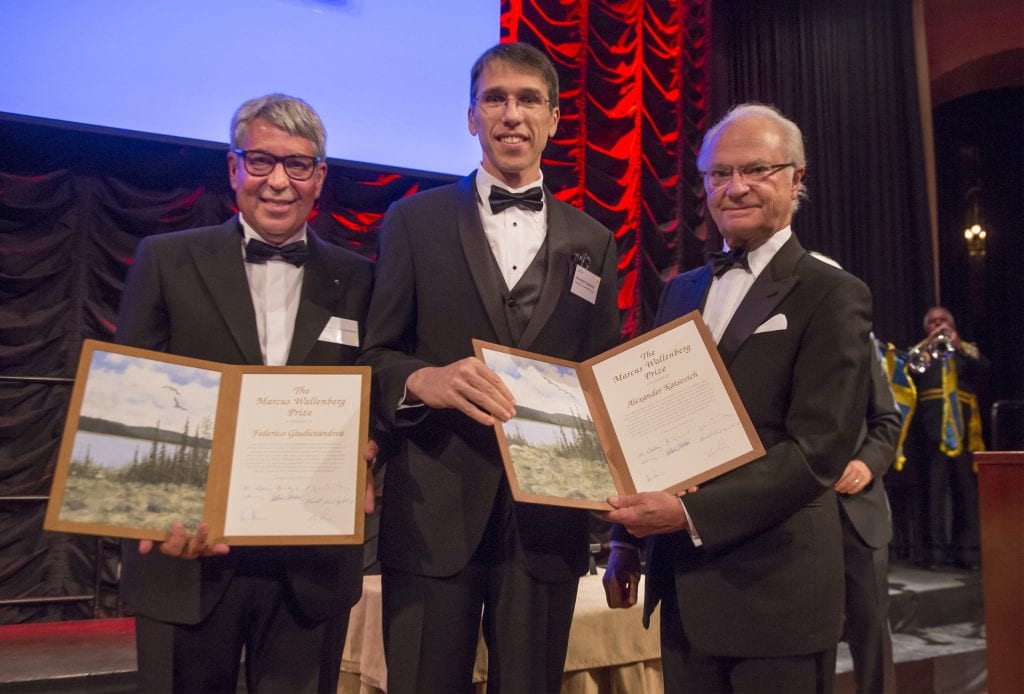A Prize From a King
To read full release visit: The Marcus Wallenberg Foundation
 Alexander Katsevich, Ph.D., mathematics professor at the University of Central Florida, won a world renowned prize for his invention, presented from His Majesty the King of Sweden.
Alexander Katsevich, Ph.D., mathematics professor at the University of Central Florida, won a world renowned prize for his invention, presented from His Majesty the King of Sweden.
On Monday, October 10, 2016 Katsevich and co-recipient Federico Giudiceandrea, Ph.D., were awarded the 2016 Marcus Wallenberg Prize of 2 million Swedish Krona for the development of a computed tomography scanner for whole tree logs.
The high speed X-ray based scanning machine was built using the algorithm developed by Katsevich, UCF professor and CTO of iTomography, and implemented by Giudiceandrea, CEO of Microtec in Brixen, Italy.
Non-destructive scanning of round wood has made online optimization of log usage in the sawmilling process possible. Knots, resin pockets, tree rings, cracks and rot can be identified before the timber is sawn. The wood density can also be determined.
The introduction of this new technology marks the beginning of a new era for the sawmill industry.
“The groundbreaking research and innovative implementation have opened new horizons, facilitating further optimization of the sawing process,” says Marcus Wallenberg, chairman of the board of the Marcus Wallenberg Prize.
Computed tomography, CT, is an imaging technology that produces three-dimensional (3D) representations of objects, based on multiple views of the object from different directions with penetrating X-ray radiation.
In most modern industrial and medical CT scanners the X-ray is emitted from the source in a cone beam geometry, and the images are reconstructed with an algorithm after the object is moved through the beam. In a majority of scanners, the source and detector rotate around the object during the process.
Until 2001, reconstruction algorithms that were fast enough to be used in a sawmill were approximate in their nature. They were reliable only for small cone angles. But for wider cone angles, which is required for a faster scanner, they would produce images with artifacts.
The breakthrough by Katsevich was to find an exact analytical reconstruction algorithm, which is known today as Katsevich’s Algorithm. On one hand, this algorithm is accurate for all cone angles. On the other hand, it is fast and can be used in a scanner that is required to produce images in real time.
The algorithm was refined to solve the cone-beam problem in the situations where movement of tree logs through the scanner with non-constant speed is necessary.
Federico Giudiceandrea collaborated with Alexander Katsevich in implementing the Katsevich Algorithm and was ultimately successful in building a prototype, which no one thought would be possible.
It has been further developed and marketed worldwide. Wood industries in Chile, the U.S., Germany and France have invested in their CT scanners to make the most of the round wood resource.
The log scanner has an outstanding throughput compared to other CT-scanners. It has a belt speed of 120 meters per minute, to keep pace with modern sawing lines.
In modern sawmills where 3D scanning of the log is used, approximately 10 to 15 percent increase in value of the output can be derived. A potential increase of 20 to 25 percent is possible if all the advantages of having access to the internal features of the timber are realized. An investment in this kind of equipment is likely to have a payback time of not much more than a year for an average-sized sawmill.
Grading has been the only realistic way to keep quality within desired limits. The CT log scanner however enables a way of controlling the quality of the output from a log by directing the sawing pattern.
“This creates new possibilities for wood as an engineering material,” says Carl Johan Johansson, former member of the Selection Committee of the Marcus Wallenberg Prize.
Katsevich and Giudiceandrea received the award from the hand of His Majesty the King of Sweden at a ceremony in Stockholm on Monday, October 10, 2016.
The purpose of the Marcus Wallenberg Prize is to recognize, encourage and stimulate path breaking scientific achievements, which contribute significantly to broadening knowledge and to technical development within the fields of importance to forestry and forest industries. The prize was awarded at a ceremony in October in Stockholm, Sweden. The official citation and prize motivation is published on www.mwp.org.
